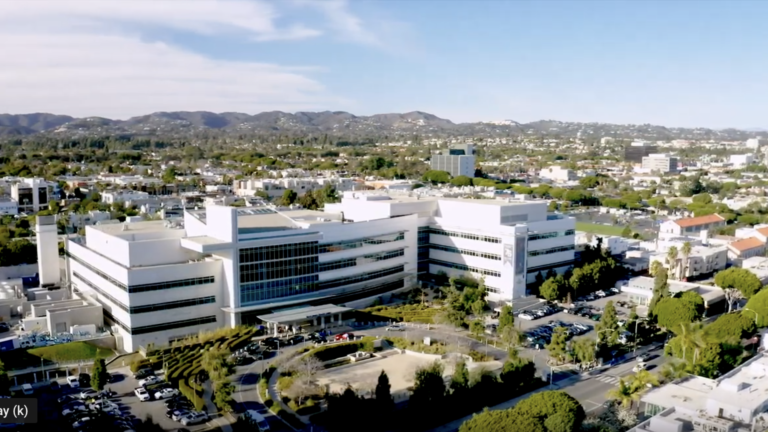Knowing Your Prolactinoma is in the Right Hands
Superior Treatment for Patients with Prolactinomas
As one of the most comprehensive pituitary disorder programs in the United States, the Pacific Pituitary Disorders Center at Pacific Neuroscience Institute (PNI) offers world-class expert care. Among the top ranked neurology and neurosurgery programs in the nation, our center’s compassionate multidisciplinary specialists provide advanced, personalized treatment while focusing on our patients’ quality of life.
Affiliated with award-winning Providence hospitals Saint John’s Health Center and Little Company of Mary, PNI neurosurgeons lead the way in advancing safer, more effective keyhole and minimally invasive endoscopic pituitary tumor removal approaches.
If you, a family member, or friend have a new diagnosis, require a second opinion, or have a pituitary tumor or related hormonal disorders recurrence, our expert physicians can help you understand your condition and determine an optimal treatment plan.
Think Pituitay. Think PNI.
Contact Us
For information about pituitary disorder treatment please complete the form below. We will respond to you within 12-24 hours. To speak with someone right away contact us at 213-214-2526.
Symptoms
In most women, prolactinomas are detected when they are smaller (microadenomas) and the prolactin level is moderately elevated (50 – 300 ng/ml). A relatively small elevation in prolactin will cause irregular menstrual periods or amenorrhea and galactorrhea.
In contrast, in men prolactinomas are typically detected when they are larger (macroadenomas), with prolactin levels over 500 – 1000 ng/ml. Most men with a prolactinoma have some degree of pituitary failure (Hypopituitarism), especially hypogonadism.
Women and men also typically have a reduced sex drive (decreased libido) and weight gain. With larger tumors, headaches and visual loss (from compression of the optic nerves or optic chiasm) can occur. A minority of patients with large tumors may have hemorrhage into a tumor (pituitary apoplexy) causing rapid onset of headache, visual loss, double vision, and pituitary failure.
Diagnosis
Prolactinomas are typically diagnosed because of problems related to high blood prolactin levels and associated hypogonadism (low sex hormones) and weight gain. A prolactin level of over 150-200 ng/ml is almost always due to a prolactinoma. However, moderate prolactin elevations (30-200 ng/ml) can occur from other causes such as pregnancy, stress (discomfort, exercise), low thyroid function (hypothyroidism), kidney or liver failure and medications (e.g., haloperidol, antidepressants, verapamil). An additional cause of high prolactin level is “stalk compression effect” from a pituitary or brain tumor that compresses the pituitary stalk. Other adenomas, craniopharyngiomas, Rathke’s cleft cysts and other brain tumors may cause modest prolactin in the range of 40 – 150 ng/ml.
Prolactinomas can best be visualized on a pituitary MRI performed with and without Gadolinium.
In cases of macroprolactinomas, these larger tumors in addition to hypogonadism, may cause other pituitary hormonal deficiencies from gland compression (such as low thyorid or cortisol hormones), headaches or visual loss (from adenoma compression of the optic nerves or optic chiasm). Finally, some larger prolactinomas are diagnosed when they hemorrhage (bleeding), also known as pituitary apoplexy.
Treatment
- Medical Therapy
In general, first line treatment for patients with a prolactinoma is medication rather than endonasal surgery. Approximately 80-85% of patients will have prolactin levels restored to normal with dopamine agonist therapy and many will have marked tumor shrinkage. The most commonly used agent is cabergoline (Dostinex) which has replaced bromocriptine (Parlodel) as the drug of choice given cabergoline’s higher success rate and lower side-effect rate. Most women, following treatment, have a return of menses and many become fertile again. Tumor shrinkage occurs in the majority of patients, which often results in rapidly improved vision and headache resolution.
Dostinex has the advantage of only being taken twice per week and has fewer side effects than bromocriptine. It has also been shown effective in patients whose prolactinomas are resistant to bromocriptine therapy. The usual starting dose is 0.5 mg twice per week. The dose may be increased up to 1.0 mg twice per week. Bromocriptine is used infrequently now for prolactinomas given the higher rate of side-effects and is usually started at a low dose (2.5 mg/day) to minimize nausea and other side effects. The dose is then increased over several days or weeks to a daily maximum usually not over 10 mgs. Recent reports indicate long-term high-dose therapy with cabergoline or bromocriptine can result in valvular heart disease. Although this risk is relatively low with standard doses of cabergoline and bromocriptine used to treat a prolactinoma, it remains a potential risk of this therapy. - Endoscopic Endonasal Surgery
Surgery is a reasonable first-line therapy in patients with micro-prolactinomas that do not invade the cavernous sinus and whose prolactin level is less than 250 ng/ml. In these patients, long term remission is generally 80-90%. Endonasal surgery is also effective for lowing prolactin levels in patients intolerant of cabergoline. For invasive microprolactinomas with prolactin levels over 1000 ng/ml, the surgical cure rate is low, averaging less than 30%. For this reason, cabergoline is usually tried first. In patients with long-standing visual loss from tumor compression, cabergoline can be tried first. However, if visual loss has occurred rapidly over a period of several days or weeks, or if there is evidence on MRI of subacute hemorrhage or degeneration in the tumor, endonasal surgery for tumor debulking is generally recommended. Because of improved tumor visualization, the endoscopic endonasal approach is rapidly becoming the preferred method for removal of most pituitary adenomas, including prolactinomas who are not responsive to cabergoline. - Radiosurgery (SRS) or Stereotactic Radiotherapy (SRT)
Because most patients with prolactinomas respond so well to dopamine agonist therapy and/or surgery, radiosurgery or radiation therapy are rarely required.
Our Physicians
Click on our award-winning physicians below to learn more about them:
Patient Experience
 Pituitary Disorders Center
Pituitary Disorders Center
 Dennis’ Story – Pituitary Adenoma
Experience an actual account of Pituitary Adenoma.
Dennis’ Story – Pituitary Adenoma
Experience an actual account of Pituitary Adenoma.
 Ajay’s Story – Pituitary Adenoma
Experience an actual account of Pituitary Adenoma.
Ajay’s Story – Pituitary Adenoma
Experience an actual account of Pituitary Adenoma.

Pituitary Disorders Center

Dennis’ Story | Pituitary Adenoma









